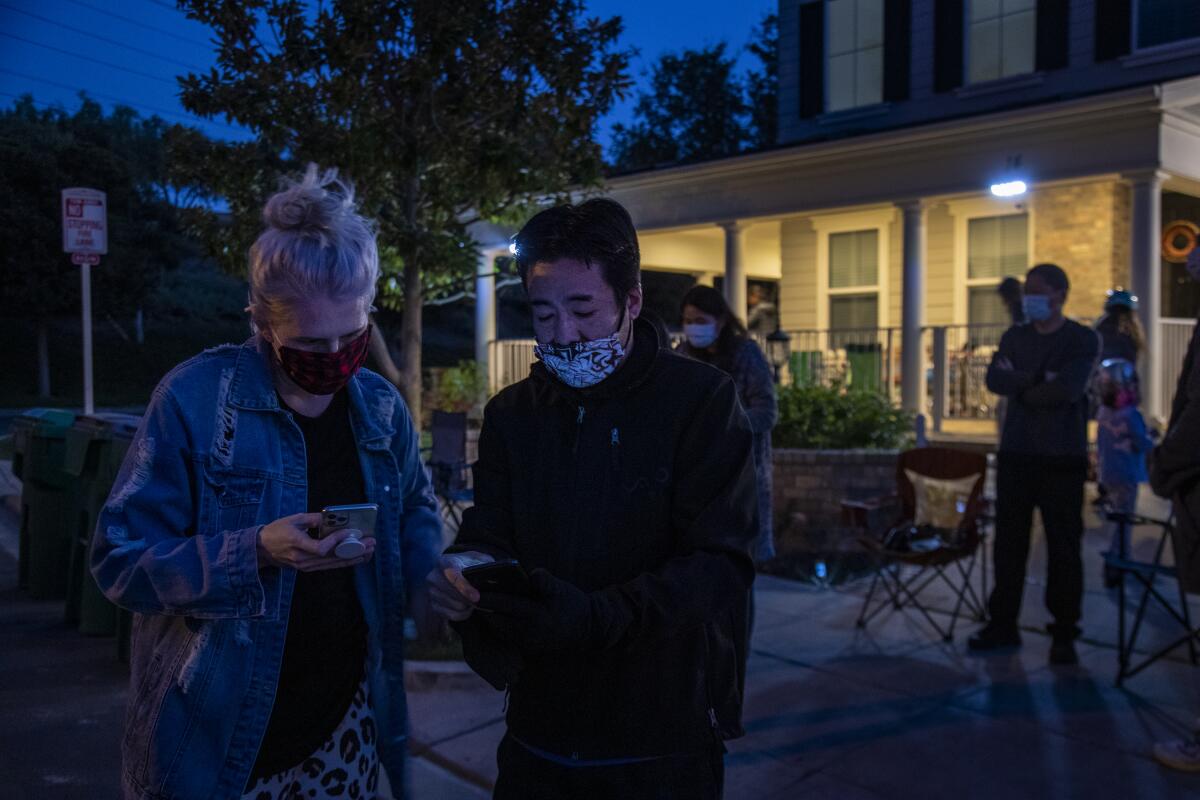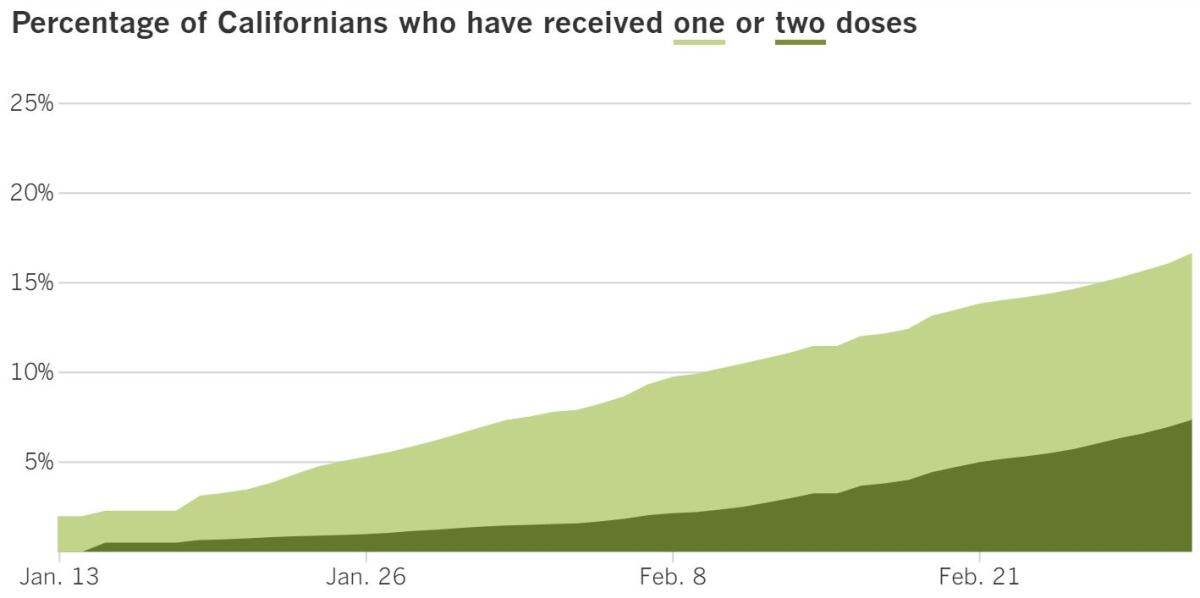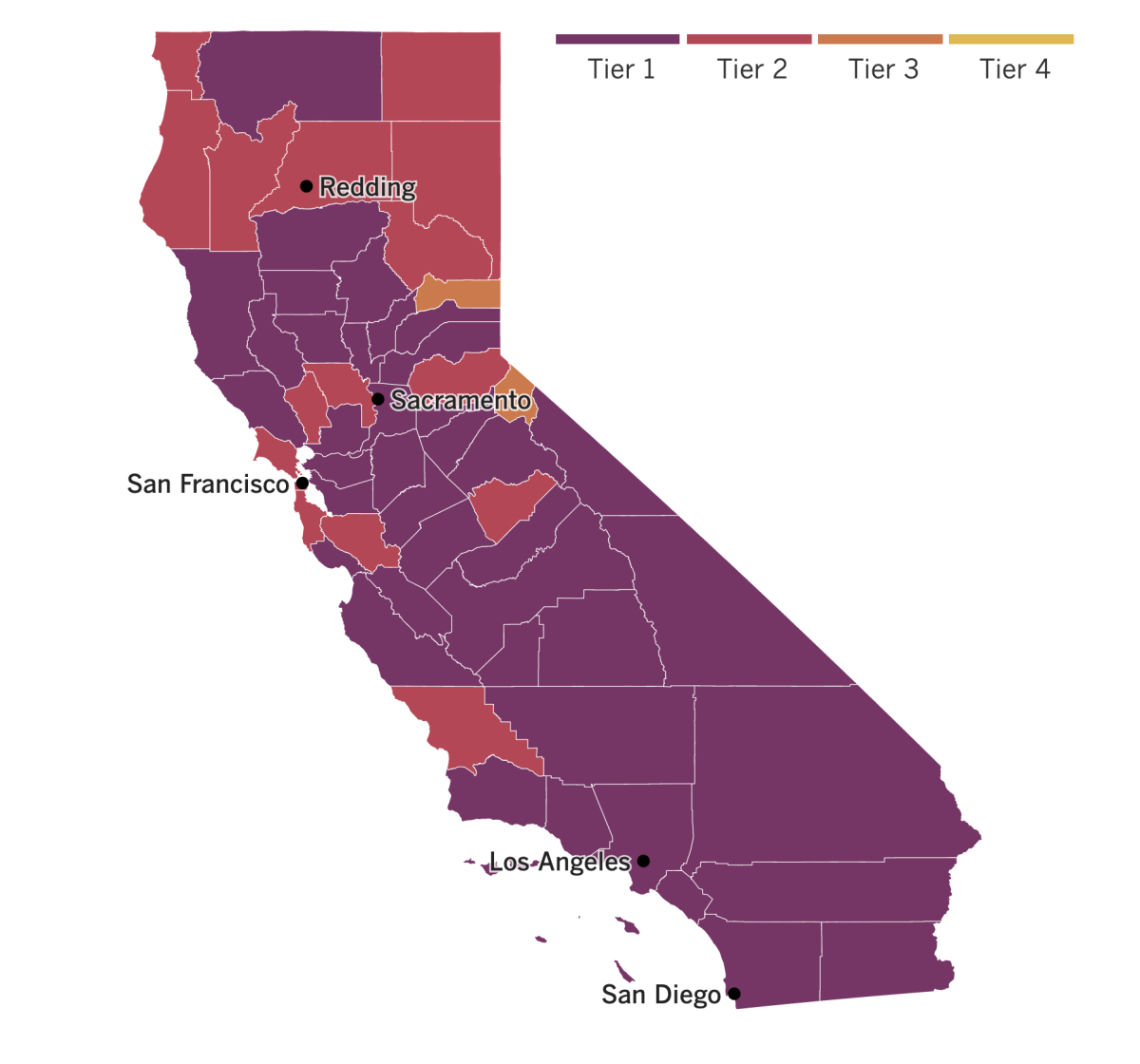Coronavirus Today: Fighting anti-Asian racism
Good evening. I’m Thuc Nhi Nguyen, and it’s Tuesday, March 2. Here’s what’s happening with the coronavirus in California and beyond.
A new iron fence, security cameras and seven calls to police weren’t enough to stop teenagers from harassing the Si family almost every night after they moved into their Ladera Ranch home last September.
Then a team of neighbors stepped in, armed with camping chairs and warm sweaters, my colleague Hannah Fry reports.
The neighbors act as a volunteer security detail for Haijun Si and his family to ward off the teens who yell racist slurs and tell them to “go back to your country.” The harassers throw rocks, ring the doorbell at odd hours of the night and pound on the door. Si’s 8-year-old daughter and 5-year-old son are scared.
Some may brush it off as “kids being kids,” but the neighbors who volunteered to help aren’t settling for that excuse.
“No,” Emily Lippincott said. “This is months of terrorizing this poor family.”
The types of racist attacks the Si family has faced are growing increasingly — and disturbingly — common. Last year, California saw a steady increase in hate incidents and crimes targeting Asian Americans, said Brian Levin, executive director of the Center for the Study of Hate and Extremism at Cal State San Bernardino.
Conspiracy theories blaming Asians for the COVID-19 pandemic have been embraced by wide swaths of the country. Experts lay part of the blame on former President Trump’s rhetoric, including his use of terms such as “China virus” and “kung flu.”
Violent attacks in Oakland, San Francisco, New York City and elsewhere have sparked fear among Asian Americans. In L.A.’s Koreatown, two men hurled anti-Asian slurs at a 27-year-old Korean American U.S. Air Force veteran last month, calling him “Chinese virus” and then swinging at him, he told KTLA.
In Ladera Ranch, Layla Parks met the Si family when they moved in. In February, Si reached out to ask for advice about how to handle the harassment. Parks didn’t understand the extent of the attacks at first, but when she heard of the racist slurs, she realized she had to do something.
Parks recruited volunteers to stand guard at the two-story home from 6 p.m. until at least midnight. She also posted video footage of an attack to a neighborhood Facebook group.

“It makes me physically ill,” said Parks, 30. “This has opened my eyes to the racism that is alive and well in Ladera Ranch. It’s definitely made me sad for this community, because this is just a wonderful place full of friends and neighbors that love and care about each other.”
Some neighbors keep watch in front of the Si family’s driveway. Others monitor from their cars or patrol the nearby parks. They estimate that 15 to 20 children have participated in the harassment, including one as young as 10.
Three children have apologized, Si said. But Parks said one family sent a cease-and-desist letter after seeing their child in security footage she posted on Facebook. The letter threatened her with a lawsuit if she didn’t remove her post.
By the numbers
California cases, deaths and vaccinations as of 6:14 p.m. on Tuesday:

Track California’s coronavirus spread and vaccination efforts — including the latest numbers and how they break down — with our graphics.

Across California
California’s contract to hand over vaccine distribution to Blue Shield of California was meant to streamline a process that was previously handled by local authorities on a location-by-location basis. The old system was fraught with challenges, including the existence of at least 61 separate lists explaining different priority groups. Finding a clear explanation of the rules seemed impossible.
But for farmworkers in the San Joaquin Valley preparing for harvest season, moving to a new, unknown system may be worse, my colleague Anita Chabria reports.
The insurance company plans to allocate vaccine using an algorithm that calculates where doses should go based on need. Though it was designed to address inequities in the system, few details about the process have been released to the public.
As a result, neither farmworkers nor their advocates — including elected officials, unions, nonprofits and employers who previously organized clinics using personal connections — know how to help these essential workers get their shots.
“How can we do this together?” asked Maria Lemus, executive director of nonprofit Visión y Compromiso, a network of promotores, members of vulnerable communities who are trained health liaisons. “Invite me to the party. I am happy to help.”
Blue Shield referred questions to the California Department of Public Health. A state official said local health departments will lose most but not all direct control of vaccine, adding that the list of those allowed to administer the shots will be narrowed down to ones the insurance company determines are most capable of reaching equity and speed goals.
In Los Angeles County, where Blue Shield has not yet taken over vaccine duties, local officials began setting up small clinics that are strategically located to bring more doses to underserved communities.
One such clinic opened Tuesday in Pacoima, with others to follow in Sylmar and Tujunga. Appointments are available to residents of North Hills, Mission Hills, Lakeview Terrace and Shadow Hills who are over the age of 65, who live in long-term care facilities or who work in healthcare, food service, education and child care, agriculture or emergency services.
Setting up clinics that are restricted to people living in the hardest-hit communities is one way to address the COVID-19 vaccine inequities in the county. Recently released data continue to show that the areas suffering most from the pandemic are among the slowest to get vaccinated.
It’s Tuesday, and that means moving day for some lucky counties. State health officials announced that seven more counties are now free to exit the purple tier, the strictest in the state’s four-tier reopening plan. Santa Clara, San Francisco, San Luis Obispo, El Dorado, Napa, Lassen and Modoc counties will join the red tier, which means residents there can return to indoor activities like restaurant dining (at 25% capacity) and working out at a gym (at 10% capacity).
As case rates fall statewide, more populous areas are starting to inch toward reopening. About 5 million Californians are now outside of the state’s most restrictive category, compared with 1.6 million residents last week.
Although L.A. County has not yet budged from the purple tier (keep reading for more on that below, in the Your Questions Answered section), plummeting case rates have encouraged some in the area to start moving back to business as (almost) usual.


See the latest on California’s coronavirus closures and reopenings, and the metrics that inform them, with our tracker.
Consider subscribing to the Los Angeles Times
Your support helps us deliver the news that matters most. Become a subscriber.
Around the nation and the world
Congress is getting ready to approve another stimulus package this month, and many are looking forward to the financial boost it will bring. Struggling individuals may already be planning how to spend their checks, and small business owners need the support more than ever.
But the people eagerly tracking Congress’ progress on the bill also include cyber criminals, my colleague Sarah D. Wire reports. For those who prey on weak online systems like the ones used to guard unemployment benefits, “it’s like Christmas,” one expert said.
Experts are encouraging the government to strengthen the stimulus bill with tools to prevent the kind of fraud that resulted in scammers siphoning off more than $40 billion in unemployment benefits last year.
In some cases, learning how to get around the online portals’ defenses is as simple as watching a YouTube video.
When gig workers and self-employed people became eligible for unemployment benefits, filing a claim was as easy as entering a name, date of birth, address, Social Security number and bank account. That information wasn’t hard for fraudsters to obtain, considering that Social Security numbers can be purchased on the dark web for $4, and driver’s licenses can be had for $25. Once false claims were filed by international crime rings, American “mules” were sent to collect the checks at local addresses and send them overseas.
“They’ve left everything wide open,” said Brett Johnson, a former criminal who is now a cybercrime advisor for federal law enforcement. “It is a complete nightmare scenario.”
One nightmare scenario that’s quickly improving is the nation’s vaccine rollout. On Tuesday, President Biden said the United States would have enough COVID-19 vaccine to inoculate every American adult by the end of May.
A new agreement that allows Merck to produce the newly authorized one-dose vaccine developed by Johnson & Johnson will shave two months off the original timeline. The unusual partnership between two pharmaceutical giants that are normally competitors is “the type of collaboration between companies that we saw during World War II,” Biden said.
People who are already vaccinated can look forward to more good news, as the Centers for Disease Control and Prevention could soon clear people who have been fully vaccinated to gather in small groups without masks. For example, small indoor dinner parties where all participants have received both doses of a COVID-19 vaccine present a relatively low risk, said Dr. Anthony Fauci, the nation’s leading expert on infectious diseases.
The CDC is still cautious about fully vaccinated people traveling and being out in public, though. People are advised to wear masks even if they’ve been fully vaccinated, because it’s unknown whether a vaccinated person can be an asymptomatic carrier of the coronavirus and spread the virus to someone else.
That message hasn’t quite sunk in Texas, where Gov. Greg Abbott lifted the state’s mask mandate Tuesday amid declining hospitalizations and infection rates. He will also allow all businesses to open at 100% capacity starting March 10.
“Removing statewide mandates does not end personal responsibility,” said Abbott, speaking from a crowded dining room where many of those surrounding him were not wearing masks. “It’s just that now state mandates are no longer needed.”
Although the country has made significant progress since the winter surge, federal officials are worried that some of the new coronavirus variants could sicken people who have already been infected or vaccinated. That’s why they’re encouraging people to continue following public health guidelines while the vaccination effort moves forward.
According to Our World in Data, a project based at Oxford University, the U.S. had administered 76.9 million doses of COVID-19 vaccines as of Monday. That accounts for 30.8% of the total doses in the world, even though the country accounts for only 4% of the global population. (The U.S. also has more than its share of COVID-19 deaths, with about 20% of the global total, according to data from Johns Hopkins University.)
Rich countries like the U.S. have dominated the world’s vaccine supply, especially doses made by Western companies like Pfizer and BioNTech and by Moderna. Many low- and middle-income countries have to turn elsewhere.
China is offering backup. The country has made about half a billion doses of its vaccines available to more than 45 countries. When a delivery of doses arrived in Chile in January, the country’s president, Sebastián Piñera, called it “a day of joy, emotion and hope.”
The vaccines made in China by Sinovac, Sinopharm and CanSino are some of the only options poorer countries have, because deliveries from other countries were delayed and often much smaller than promised. But data about the shots’ safety are spotty, since no late-stage clinical trial data have been released for any of those three vaccines.
Despite this, many countries have welcomed China’s “vaccine diplomacy” because their desire to tame the pandemic ultimately outweighed their worries. “Vaccines, particularly those made in the West, are reserved for rich countries,” said one Egyptian official. “We had to guarantee a vaccine. Any vaccine.”
Your questions answered
Today’s question comes from readers who want to know: How close is L.A. County to moving into the red tier?
It could happen in a matter of weeks, health officials say.
There are three key criteria California uses to determine a county’s tier assignment: the adjusted case rate, the coronavirus test positivity rate and the health equity metric. In general, a county has to meet the criteria in all relevant categories for two weeks running before moving to the next tier. (The equity index applies only to the 35 counties with at least 106,000 residents.)
The state updates its tier assignments each Tuesday, announcing which counties get to make a move and which are on deck to move the following week. L.A. County didn’t make the cut today — but a host of others did.
L.A. County’s performance in two of the three categories would be good enough to qualify not just for the red tier but for the orange tier, which is even less restrictive. Our performance on the third metric is significantly worse.
As of Tuesday, the test positivity rate is 3.5%, and the health equity index score — which measures whether positive tests in the most disadvantaged neighborhoods are significantly higher than a county’s overall rate — is 5.1.
But the metric that has held Los Angeles back since the four-tier system was introduced in August is the adjusted case rate.

In order to make it into the red tier, L.A. County needs its adjusted case rate to be no higher than 7.0 new cases per day per 100,000 people. As of Tuesday, it’s at 7.2.
But that number has been falling fast — last week, it was 12.3, and the week before, it was 20. At the height of the holiday surge in January, L.A. County’s adjusted case rate was a whopping 77.
L.A. County has hit the 7.0 mark before, in late September. But the following week, the adjusted case rate rose back to 7.3, and it hasn’t been that low again until now.
In a statement to The Times, the L.A. County Department of Public Health said the agency is hopeful the county will qualify for the red tier next week. If things hold steady, L.A. County could finally enter the red tier March 17.
Once the county is in the red tier, it will have to stay there for at least three weeks before it can move into the orange tier, assuming it meets all three criteria for doing so.
My colleagues on The Times’ data desk are tracking California’s reopening, and you can follow your own county here.
We want to hear from you. Email us your coronavirus questions, and we’ll do our best to answer them. Wondering if your question’s already been answered? Check out our archive here.
Resources
Need a vaccine? Keep in mind that supplies are limited, and getting one can be a challenge. Sign up for email updates, check your eligibility and, if you’re eligible, make an appointment where you live: City of Los Angeles | Los Angeles County | Kern County | Orange County | Riverside County | San Bernardino County | San Diego County | San Luis Obispo County | Santa Barbara County | Ventura County
Practice social distancing using these tips, and wear a mask or two.
Watch for symptoms such as fever, cough, shortness of breath, chills, shaking with chills, muscle pain, headache, sore throat and loss of taste or smell. Here’s what to look for and when.
Need to get tested? Here’s where you can in L.A. County and around California.
Americans are hurting in many ways. We have advice for helping kids cope, resources for people experiencing domestic abuse and a newsletter to help you make ends meet.
We’ve answered hundreds of readers’ questions. Explore them in our archive here.
For our most up-to-date coverage, visit our homepage and our Health section, get our breaking news alerts, and follow us on Twitter and Instagram.




